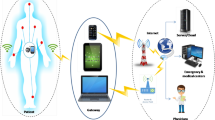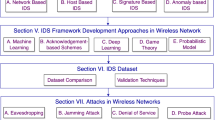Abstract
Interference is generally considered as the redundant and unwanted occurrence in wireless communication. This research work proposes a novel cooperative jamming mechanism for scalable networks like wireless sensor networks which makes use of friendly interference to confuse the eavesdropper and increase its uncertainty about the source message. The communication link is built with the help of Information theoretic source and channel coding mechanisms. The whole idea is to make use of normally inactive relay nodes in the selective Decode and Forward cooperative communication and let them work as cooperative jamming sources to increase the equivocation of the eavesdropper. In this work, eavesdropper’s equivocation is compared with the main channel in terms of mutual information and secrecy capacity.












Similar content being viewed by others
References
Shannon, C. E. (1948, July and October). A mathematical theory of communication. The Bell System Technical Journal, 27, 379–423, 623–656.
Shannon, C. E. (1949). Communication theory of secrecy systems. The Bell System Technical Journal, 28, 656–715.
Scaglione, A., & Hong, Y.-W. (2003, August). Opportunistic large arrays: Cooperative transmission in wireless multihop ad-hoc networks to reach far distances. IEEE Transactions on Signal Processing, 51(8), 2082–2092.
Wyner, A. (1975). The wire-tap channel. Bell System Technical Journal, 54, 1355–1387.
Csiszar, I., & Korner, J. (1978). Broadcast channels with confidential messages. IEEE Transactions on Information Theory IT, 24(3), 339–348.
Liang, Y., Poor, H. V., & Shamai, S. (2008). Information theoretic security. Foundations and Trends in Communications and Information Theory, 5(4–5), 355–580. doi:10.1561/0100000036.
Lai, L., El Gamal, H., & Poor, H. V. (2009). Authentication over noisy channels. IEEE Transactions on Information Theory, 55, 906–916.
Massey, J. L. (1988, May). An introduction to contemporary cryptology. Proceedings of the IEEE, 76(5), 533–549.
Maurer, U. M. (2000). Authentication theory and hypothesis testing. IEEE Transactions on Information Theory, 46, 1350–1356.
Rosenbaum, U. (1993). A lower bound on authentication after having observed a sequence of messages. Journal of Cryptology, 6(3), 135–156.
Simmons, G. J. (1985). Authentication theory/coding theory. In Proceedings of the CRYPTO’84 on advances in cryptography, Lecture Notes in Computer Science (pp. 411–431) New York, NY, USA: Springer-Verlag.
Bloch, M., & Barros, J. (2011). Physical layer security: from information theory to security engineering. Cambridge: Cambridge University Press.
Chen, L. (2011). Physical layer security for cooperative relaying in broadcast networks. USA: Military Communications Conference—MILCOM, pp. 91–96.
Shiu, Y.-S., Chang, S. Y., Wu, H.-C., Huang, S. C.-H., & Chen, H.-H. (2011). Physical layer security in wireless networks: A tutorial. IEEE Wireless Communications Journals and Magazines, 18(2), 66–74.
Luo, S., Li, J., & Petropulu, A. (2012, June). Physical layer security with uncoordinated helpers implementing cooperative jamming. In Proceedings of 7th IEEE sensor array and multichannel signal processing workshop (SAM2012). Hoboken, NJ.
Han, Z., Petropulu, A. P., & Poor, H. V. (2009). Cooperative jamming for wireless physical layer security. In IEEE/SP 15th workshop on statistical signal processing. SSP’09, pp. 417–420
Huang, J. (2011). Cooperative jamming for secure communications in MIMO relay networks. IEEE Transactions on Signal Processing, 59(10), 4871–4884.
Gollakota, S., & Katabi, D. (2011, April). Physical layer wireless security made fast and channel independent. In IEEE Conference, INFOCOM, pp. 1125–1133.
Dong, L., Han, Z., Petropulu, A. P., & Poor, H. V. (2010). Improving wireless physical layer security via coperating relays. IEEE Transactions on Signal Processing, 58(3), 1875–1888.
Marcelloni, F., & Vecchio, M. (2009). An efficient lossless compression algorithm for tiny nodes of monitoring wireless sensor networks. The Computer Journal Advance Access, published April 30.
Welch, T. A. (1984). A technique for high-performance data compression. Computer, 17, 8–19.
Haykin, S. S. (2001, January) Communication systems (4th ed.). Wiley, New York.
Morelos-Zaragoza, R. H., & Lin, S. (1995). On primitive BCH codes with unequal error protection capabilities. Faculty Publications. Paper 8.
Reed, I. S., & Solomon, G. (1960). Polynomial codes over certain finite fields. Journal of the society for Industrial and Applied Mathematics, 8(2), 300–304.
George, M., Hamid, M., & Miller, A. (2011). Gold code generators in Virtex devices. XAPP217 (v1.1), pp. 1–9.
Author information
Authors and Affiliations
Corresponding author
Rights and permissions
About this article
Cite this article
Rohokale, V.M., Prasad, N.R. & Prasad, R. Reliable and Secure Cooperative Communication for Wireless Sensor Networks Making Use of Cooperative Jamming with Physical Layer Security. Wireless Pers Commun 73, 595–610 (2013). https://doi.org/10.1007/s11277-013-1205-x
Published:
Issue Date:
DOI: https://doi.org/10.1007/s11277-013-1205-x




